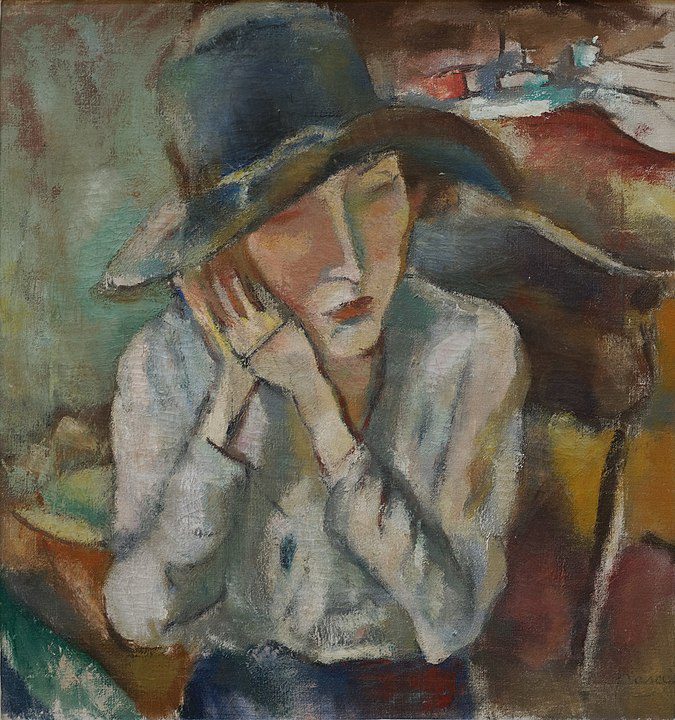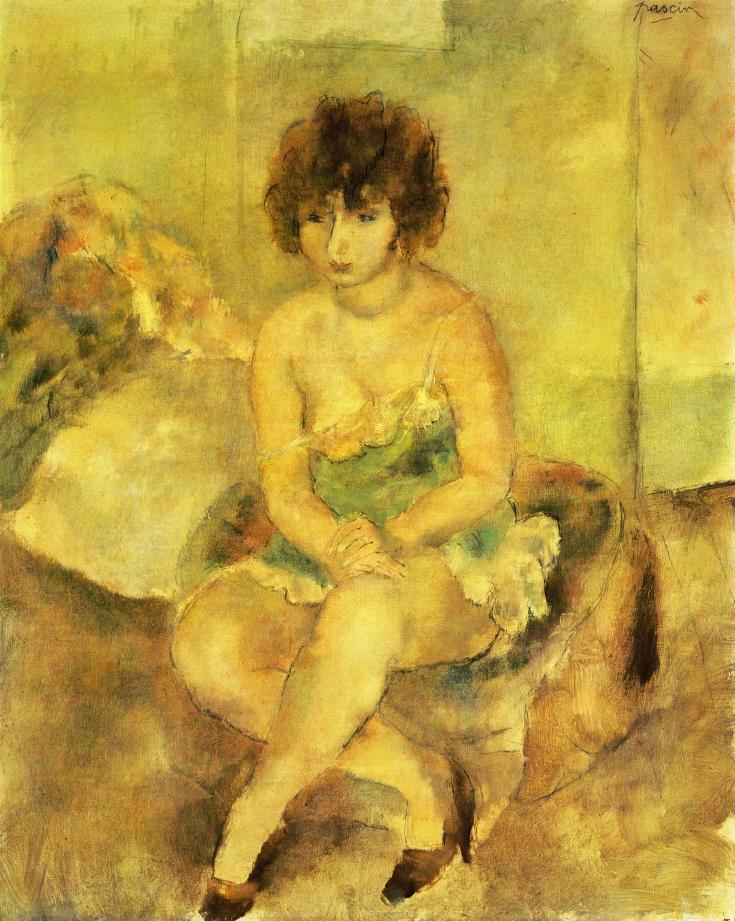
Jules Pascin, often referred to as the “Prince of Montparnasse,” remains an enduring figure in the world of modern art. Known for his captivating portraits and melancholic themes, Pascin’s life was as vibrant and complex as the art he created. This biography delves into the life and legacy of an artist whose name became synonymous with the bohemian lifestyle of early 20th-century Paris. From his formative years in Bulgaria to his immersion in Montparnasse’s artistic milieu, Pascin’s journey was marked by passion, creativity, and tragedy.
Born into a family of Sephardic Jews, Pascin’s early experiences shaped his unique worldview. His move to Paris brought him into contact with some of the most significant artists and intellectuals of the time. Despite his success, his personal struggles, including bouts of depression and the challenges of a bohemian existence, ultimately led to his tragic end. This article explores every facet of his life, from his relationships and career milestones to his artistic contributions and lasting influence on modernist painting.
Early Life and Background
Jules Pascin was born Julius Mordecai Pincas on March 31, 1885, in Vidin, Bulgaria. The youngest of eleven children, he grew up in a prosperous Sephardic Jewish family whose wealth came from the grain trade. Pascin’s upbringing in such a diverse and culturally rich environment profoundly influenced his artistic sensibilities. Vidin, located on the banks of the Danube River, was a vibrant crossroads of cultures, blending Ottoman, Balkan, and European influences.
As a child, Pascin displayed an early talent for drawing, often sketching caricatures and portraits of his family members. His parents, recognizing his potential, encouraged his education, though they hoped he would pursue a more traditional career. However, his rebellious nature and passion for art led him to seek training abroad. By his teenage years, Pascin’s interest in art had evolved into an obsession, and he began dreaming of life beyond Bulgaria’s borders.

In 1903, Pascin left Vidin for Vienna, a city renowned for its artistic and cultural life. Vienna’s thriving art scene provided him with his first exposure to formal artistic training, and he quickly absorbed the influences of the Symbolist and Expressionist movements. From Vienna, Pascin moved to Munich, where he studied at the prestigious Akademie der Bildenden Künste. These formative years set the stage for his later success as a modernist painter.
Education and Artistic Development
Pascin’s time in Munich marked a turning point in his artistic journey. At the Akademie der Bildenden Künste, he honed his technical skills while exploring new artistic styles. The city’s avant-garde circles introduced him to the works of artists like Franz von Stuck and Max Beckmann, whose bold use of color and innovative compositions left a lasting impression. Pascin’s early works from this period reveal a blend of traditional techniques and experimental approaches.
In 1905, Pascin’s ambitions took him to Paris, where he joined the vibrant artistic community of Montparnasse. Paris at the time was the epicenter of modern art, attracting luminaries like Pablo Picasso, Henri Matisse, and Amedeo Modigliani. Immersed in this dynamic environment, Pascin’s style began to mature. He embraced the modernist ethos, focusing on themes of emotional depth and human vulnerability.

Pascin’s work during this period often depicted figures with a dreamlike quality, characterized by delicate lines and muted colors. He was particularly drawn to scenes of urban life and intimate portraits, capturing the essence of his subjects with remarkable sensitivity. His time in Paris also brought him into contact with influential art dealers and collectors, who recognized his talent and helped him gain wider exposure.
By 1907, Pascin’s reputation as an artist was firmly established. His illustrations for satirical magazines like Simplicissimus showcased his wit and technical prowess, earning him a steady income. Despite his growing success, Pascin remained restless, constantly seeking new ways to express himself artistically.
Montparnasse and the Bohemian Lifestyle
In Montparnasse, Pascin became a central figure in the bohemian community. Known for his charismatic personality and insatiable appetite for life, he quickly earned the nickname “Prince of Montparnasse.” The neighborhood, with its cafés, studios, and galleries, was a haven for artists, writers, and intellectuals. Pascin’s circle of friends included figures like Modigliani, Chaim Soutine, and Kiki de Montparnasse.
Pascin’s lifestyle was as unconventional as his art. He frequented the legendary cafés of Montparnasse, such as Le Dôme and La Coupole, where he engaged in spirited debates about art and philosophy. His bohemian existence, however, came with its challenges. Pascin struggled with alcoholism and bouts of depression, which often interfered with his work.
Despite these difficulties, Pascin continued to produce art at an astonishing rate. His studio became a gathering place for artists and admirers, who were drawn to his generosity and magnetic personality. Pascin’s relationships with his peers were both collaborative and competitive, fueling his creative drive. His influence on the Montparnasse community was profound, and he played a pivotal role in shaping its artistic identity.
In addition to his friendships, Pascin’s romantic relationships were a source of inspiration and turmoil. His marriage to Hermine David, a talented painter in her own right, was marked by mutual respect and shared artistic goals. However, Pascin’s infidelity and emotional instability often strained their relationship. Despite these challenges, Hermine remained one of his closest confidantes and supporters.
Artistic Style and Notable Works
Pascin’s artistic style is characterized by its emotional depth and technical precision. His works often feature soft, ethereal lines and a muted color palette, creating a sense of intimacy and introspection. Portraiture was his preferred medium, and he had a unique ability to capture the inner lives of his subjects. His paintings often depict women, exuding a blend of sensuality and melancholy.
One of Pascin’s most celebrated works is La Rêverie (The Daydream), a portrait that epitomizes his delicate approach to composition and color. The painting’s dreamlike quality reflects Pascin’s fascination with the subconscious and emotional expression. Another notable work, The Red Scarf, showcases his mastery of texture and light, highlighting the interplay between physical form and emotional resonance.

Pascin’s versatility as an artist extended to his illustrations, which often carried a satirical edge. His drawings for magazines like Simplicissimus and Le Rire revealed his keen observational skills and sharp wit. These works provided a steady source of income, allowing him to pursue his passion for painting without financial constraints.
Throughout his career, Pascin’s art remained deeply personal, reflecting his inner struggles and longing for connection. His ability to convey complex emotions through his work earned him a devoted following, and his influence can be seen in the works of later modernist painters.
Personal Life and Relationships
Pascin’s personal life was as tumultuous as his art was refined. His marriage to Hermine David was both a source of stability and conflict. The couple shared a deep bond over their love for art, and Hermine often modeled for Pascin’s portraits. However, Pascin’s infidelity and unpredictable behavior frequently tested their relationship.
Beyond his marriage, Pascin’s romantic liaisons were a significant aspect of his life. He had numerous affairs with models, muses, and fellow artists, many of whom inspired his work. These relationships were often fraught with emotional intensity, reflecting Pascin’s complex personality and relentless pursuit of artistic authenticity.
Pascin’s friendships were equally significant. He maintained close ties with other artists in Montparnasse, including Modigliani and Soutine. These relationships provided him with both camaraderie and creative inspiration, shaping his artistic vision. Despite his bohemian lifestyle, Pascin was deeply loyal to his friends and often went out of his way to support them.
Challenges and Downfalls
While Pascin’s talent brought him fame and fortune, his life was not without its challenges. The outbreak of World War I forced him to leave Paris and seek refuge in the United States. During his time in New York, Pascin continued to create art, but the war’s impact weighed heavily on him. His work during this period often reflected themes of displacement and longing.
Pascin’s struggles with alcoholism and depression were ongoing battles. These issues were exacerbated by the pressures of his bohemian lifestyle and the demands of his career. Despite his outward charm and charisma, Pascin often felt isolated and misunderstood. His inner turmoil ultimately overshadowed his success, leading to his tragic demise.
Tragic End and Legacy
On June 5, 1930, Pascin took his own life in his Paris studio. His death sent shockwaves through the art world, and his funeral became a poignant tribute to his impact on the Montparnasse community. Friends, admirers, and fellow artists gathered to pay their respects, mourning the loss of a brilliant and deeply complex individual.
Pascin’s legacy endures through his art, which continues to captivate audiences around the world. His ability to convey the depths of human emotion through his work has cemented his place in the history of modernist painting. As the “Prince of Montparnasse,” Pascin remains a symbol of artistic passion and bohemian creativity.
Pascin in Popular Culture
Pascin’s life and work have been celebrated in various forms of popular culture. His story has inspired books, films, and exhibitions, highlighting his enduring influence on the art world. Museums around the world continue to showcase his paintings, drawing new generations of admirers.
Key Takeaways
- Jules Pascin was a key figure in the Montparnasse art scene of early 20th-century Paris.
- His unique style blended delicate lines and muted colors to evoke emotional depth.
- Relationships with figures like Modigliani and Soutine shaped his artistic journey.
- Despite his success, Pascin struggled with depression and alcoholism.
- His legacy continues to influence modernist art and captivate audiences worldwide.
FAQs
- What is Jules Pascin best known for? He is best known for his portraits and contributions to modernist painting.
- When and where was Jules Pascin born? He was born on March 31, 1885, in Vidin, Bulgaria.
- What were Pascin’s main artistic influences? Influences included Symbolism, Expressionism, and the Montparnasse art community.
- What is Pascin’s legacy in the art world? His works continue to be celebrated for their emotional depth and modernist style.
- Where can I see Pascin’s work today? His paintings are exhibited in major museums and private collections worldwide.




